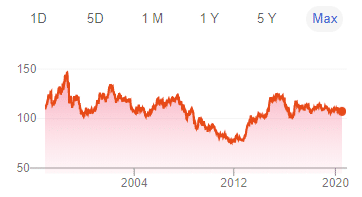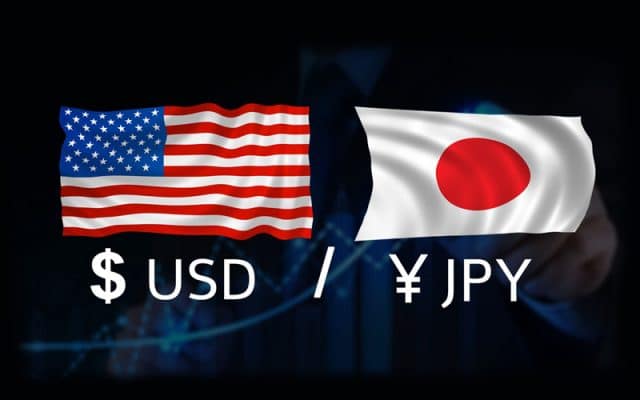USD/JPY Introduction
The USD/JPY pair is the second most liquid currency pair after only the EUR/USD pair. Traders popularly call it “the Ninja”. The Japanese Yen is among the top seven currencies that account for about 83% of the forex market. It is one of the largest currencies in terms of foreign exchange trading and international trade. With one of the largest economies behind it, Japan’s GDP ranks among the highest in the world and is also one of the largest exporters in terms of dollars.
The Bank of Japan backs the Yen and like most developed countries, and has the mandate to take measures ensuring growth and minimizing inflation. However, deflation has been a key persistent threat for a multitude of years. In the hopes of stimulating demand and economic growth, the BOJ has thus implemented a policy of low rates. In fact, real interest rates in Japan were slightly negative at various points throughout the 2010s.
For the past 20 years, the Japanese economy has been sluggish, with growth rarely venturing beyond the 2% mark. It’s a service economy which also consists of a fair share of exporters such as various consumer electronics companies and major automobile manufacturers. Since the 1990s real estate and technology bubbles, the economy hasn’t really recovered.
Carry Trade in JPY
The Carrying Trading refers to investing in higher-yielding assets from other countries after borrowing money in a low-interest-rate environment. Yen carry trading involves investors borrowing the Yen at a low-interest rate, subsequently purchasing U.S. dollars or any other national currency which pays a higher bond interest rate. As a result, the forex traders earn low-risk profit by paying low-interest rates on the borrowed money while receiving high-interest rates on the invested money. The difference is paid by the currency broker into the trader’s account daily.
Japan has always been a major source of capital for carrying trades because of BOJ’s near-zero interest rates. This also means that any fear of interest rates increasing in Japan sends shockwaves throughout currency markets.
What Moves USD/JPY?
The release of figures such as GDP, retail sales, inflation, trade balances, industrial production, and other economic data are major drivers of this pair. Investors should also take note of interest rates, employment information, and daily news flow. News about upcoming elections, natural calamities, and new government policies can significantly impact exchange rates for this pair.
Theories exist such as the Purchasing power parity, Fisher effect, interest rate parity, and balance of payments, all of which attempt to explain the foreign exchange rates. However, these models seldom playout, as described, as the real market exchange rates are affected by supply and demand. This involves many market psychology factors.
Figures which the US Federal Reserve releases, also has an impact on the pair, with the majority of decisions forming long-lasting trends on the pair.

Market Risk Appetite
It’s true that the BoJ has maintained historically low-interest rates, ever since the collapse of Japan’s property bubble. However, it has also been involved in currency intervention, when it has sold the Yen to assist Japanese exports to become more competitive.
Another factor that impacts BoJ policy and in turn forex rates is Japan’s trade balance. Japan has a very large public debt and an aging population, even though it historically had large trade surpluses. A large percentage of Japan’s debt is held domestically, even though they produce low rates of returns.
Bank of Japan (BoJ)
The BoJ in its pursuit to achieve price stability had set a target of 2% inflation per annum. It has also introduced measures such as interest rate targeting, a large QE program, and negative interest rates to raise inflation. According to the data the BoJ released, its short-term interest rate is -0.1%. It has also maintained the target for Japanese government bond yield at zero. Their target inflation rate is 2. The national debt to GDP Ratio of Japan was 200.6% of the GDP in 2019.
The BoJ has intervened thirteen times in foreign exchange rates for the Yen since September 1985 before they embarked on a new monetary expansion under new chief Haruhiko Kuroda.
Some of the highlights of these policies over the year include:
- The Plaza Accord in 1985 to weaken the dollar
- Last coordinated intervention of the BoJ with European Banks on August 15, 1995, to prop up the dollar
- BoJ intervenes to support the Yen in April- June 1998. U.S Authorities eventually backed these decisions.
- Due to worries that a strong value for the Yen will kill of economic recovery, the BoJ sells the Yen eighteen times in January 1999 to April 2000
- BoJ Sells the Yen After the September 11th Terrorist attacks in 2001
- In 2011, BoJ conducted its last intervention when the Yen fell from 75.30 per dollar, a record high at that time.
Economic Data, Tankan Survey, and Debt
There are some particular and peculiar attributes that apply to the Japanese economy. It has notably been lacking in growth despite its size since the collapse of the real estate or equity bubbles in 1990. The ensuing years are often labeled as the lost decade because of it. Growth rarely exceeded the 2% mark between 2001-2011. From 2012 to 2015, growth went down to 29%. Because Japan has experienced deflation for the last 20 years which makes it notable for its almost absent inflation rate.
In spite of being the oldest major economies, Japan ranks as one of the lowest when it comes to fertility rates which suggest a rapidly aging workforce. This means there is a lack of younger workers to support the economy through consumption and taxation.
When it comes to traders and investors of the Japanese Yen, the Tankan survey published by the BoJ on a quarterly basis is noteworthy. The survey consists of four categories and 26 items and numerous Japanese businesses take part. The Tankan survey has considerable influence on the currency rate as well as stock prices. Traders consider it a leading gauge of the economic growth of Japan.
The Conclusion
Traders are more comfortable with Japan’s debt balance in spite of its very high debt levels. They tend to balance it with Japan’s consistently high trade surplus. The relative safe-haven status of the Yen and the devaluation of the dollar have started making the currency so strong that it is threatening the trade surpluses which it produces. Looser monetary policies by the BoJ has also threatened the carry trading benefits the pair provides.




